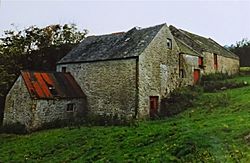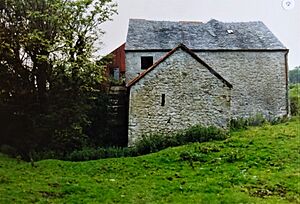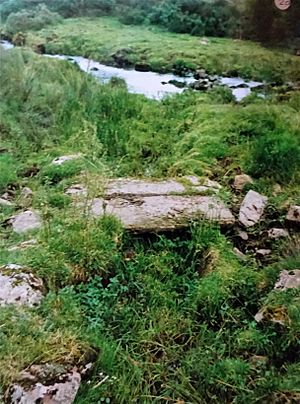Coldstream Mill facts for kids
Quick facts for kids Coldstream Mill, Beith |
|
|---|---|

Coldstream Mill
|
|
| Origin | |
| Mill name | Coldstream |
| Mill location | Beith, North Ayrshire |
| Grid reference | NS385544 |
| Coordinates | 55°45′22″N 4°34′27″W / 55.7561°N 4.5742°W |
| Operator(s) | Disused |
| Year built | Early 19th Century |
| Information | |
| Purpose | Meal mill |
| Type | Watermill |
| Storeys | Two |
| No. of pairs of millstones | 3 |
Coldstream Mill was an old watermill located near Beith in North Ayrshire, Scotland. It was built in the early 1800s, but there was an even older mill on the same spot. This mill used the power of the Dusk Water and Whitestone Burn to grind grain.
Coldstream Mill was very special because it was the last traditional working watermill in Ayrshire. It was also one of the last watermills in all of Scotland that worked continuously for a long time. The mill finally stopped working in 1991. Today, the old mill buildings have been turned into a private home, but the large mill pond is still there.
Contents
The Mill's Story
Coldstream Mill was originally built to serve the nearby Hessilhead Barony and its castle. Old maps from the 1600s show a mill in this area, sometimes called Whitstammil.
How the Mill Changed Over Time
The mill wasn't mentioned in official papers until 1728. However, it might have been made bigger and better around 1673. This was part of improvements made by Francis Montgomerie for his son's wedding. The family also made Hessilhead Castle much grander.
In 1820, a writer named George Robertson noted how good the lands around Coldstream were. Most mills back then only had one set of millstones. These stones could be adjusted to either remove the outer shell of grains or grind them into meal. Coldstream Mill was later expanded to have three sets of stones.
How the Mill Worked
The mill originally had two separate stone buildings. These were later joined together. The main mill building was two stories tall and shaped like an 'L'. It had three millstones inside. A smaller building was attached, and there was once a wooden storage shed.
The mill also had a kiln, which was a special oven for drying grain. It had a vent on the roof to let out heat and smoke. Over time, parts of the buildings were made taller, and the floor levels were changed. An old archway that carts used to access the mill was later blocked by an extension.
Water Power
Coldstream Mill got its power from a large mill pond. This pond was filled by the Whitestone Burn and the larger Glazert Water. These two water sources made sure the mill always had enough water.
The mill had a huge waterwheel. It was about 3 feet 6 inches wide and 20 feet tall! It was an "overshot" design, meaning water flowed over the top of the wheel to make it turn. The wheel had eight cast iron spokes and wooden buckets. It usually turned about six times per minute.
Special Wooden Gears
The main axle, which drove the millstones, had 136 special "sacrificial" teeth. These teeth were traditionally made from a very hard wood called lignum vitae. However, because this wood became expensive, they started using other hard woods like beech or hornbeam. These trees were even grown in local hedgerows for this purpose.
Why were they called "sacrificial" teeth? If the waterwheel suddenly got stuck, these wooden teeth would break first. This saved the more expensive and harder-to-replace cast iron parts of the wheel from damage. A company called Howie of Dunlop made these special teeth for the mill.
The Millers
Many different families worked at Coldstream Mill over the years.
- In 1782, John Andrew was listed as a miller.
- In 1810, William Fulton owned the mill.
- In 1815, it was sold to David Kerr and Andrew Gibson.
- William Caldwell then bought the mill, and his family owned it for the next 100 years.
- Thomas Caldwell was the miller in 1841.
- By 1871, Robert Jack was the miller.
- David Fergie took over in 1881.
- In 1891, Robert Jack became the miller again, and Thomas Caldwell's sons owned the mill.

In 1921, the Smith family bought the mill. Joseph Smith was the miller from 1911 until 1954. His son, Andrew Smith, then worked Coldstream Mill until 1991. Joseph had been a ploughman, but he had cousins who were millers at other mills, so he learned the trade.
What the Mill Produced
Coldstream Mill was mainly used to prepare animal feed. It ground things like linseed cake, beans, maize, and barley. The mill had three sets of millstones. Usually, two sets would be working while the third was being "dressed." Dressing the stones meant sharpening and servicing them, which happened every three weeks. Blacksmiths from a nearby village helped with this.
The mill could run with one, two, or all three sets of stones working. Coldstream Mill never had electricity and never needed a steam or diesel engine. The large mill pond and plenty of water meant it always had enough power.
Animal feed usually arrived by train at Lugton station from Glasgow Docks. Then, it was brought to Coldstream by cart. The finished meal was delivered to local farms using a donkey cart. During World War II, the mill was very busy, working full-time.
A group of mature trees near the mill was important. They helped prevent the wooden buckets and lining of the waterwheel from warping in the summer heat. The mill was less active in summer because animals could graze in pastures, so there was less demand for ground feed.
The Mill Pond
The Whitestone Burn and the Dusk Water fed the mill pond. The water then flowed through a channel called a "lade" to the mill. There were no large dams on the Dusk Water, just some big rocks that guided the water into the lade.
A pair of stones across the lade showed when the water level was high enough for a full day of milling. A board could be dropped between these stones to stop the water flow. This prevented too much pressure on the mill pond's walls. The mill pond is special because its dam walls are very tall and long, running alongside the mill's access road. The deepest part of the pond was about 1.8 meters (nearly 6 feet). An overflow channel led water back into the Dusk Water.
What's Left Today
Some items from Coldstream Mill are now on display at the Dalgarven Mill museum near Kilwinning. As mentioned, the mill buildings have been turned into a private house. The mill pond has also been kept as part of the property. The old waterwheel is still there as a feature, and one of the millstones has been preserved inside the house.
Images for kids











